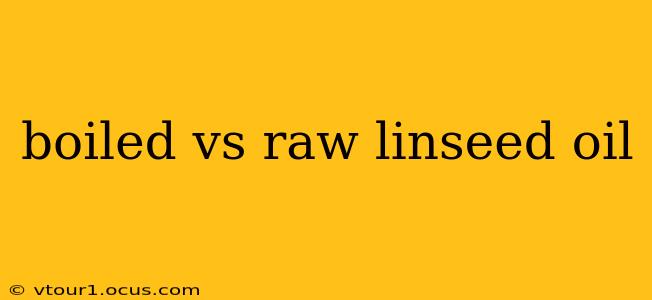Linseed oil, derived from flaxseeds, is a popular drying oil used in various applications, from painting and woodworking to protecting metal surfaces. However, the term "boiled linseed oil" can be a bit misleading. Let's delve into the differences between boiled and raw linseed oil to help you choose the right one for your project.
What is Raw Linseed Oil?
Raw linseed oil is exactly what it sounds like: linseed oil in its purest, unprocessed form. It's extracted from flaxseeds and undergoes minimal processing, retaining its natural color and properties. This means it has a slower drying time compared to its processed counterpart. Because it's less processed, it contains all the natural components of the flaxseed, including some that can contribute to slower drying times.
Advantages of Raw Linseed Oil:
- Natural and pure: Raw linseed oil is a completely natural product, free from added chemicals or metallic driers. This makes it a good choice for those seeking environmentally friendly options.
- Penetration: Its slower drying time allows it to penetrate wood more deeply, providing superior protection and nourishment. This is especially beneficial for fine woodworking and furniture finishing.
Disadvantages of Raw Linseed Oil:
- Slow drying time: This can be a significant drawback for projects where a quick turnaround is needed. The drying time can be significantly extended depending on temperature, humidity and other factors.
- Susceptibility to spoilage: Due to its natural composition, raw linseed oil is more prone to oxidation and rancidity over time, especially if not stored properly.
What is Boiled Linseed Oil?
"Boiled linseed oil" is a bit of a misnomer. It's not actually boiled, but rather treated with metallic driers (like cobalt, manganese, or lead) to accelerate the drying process. These driers are catalysts that speed up the oxidation reaction, which is crucial for the oil to harden and form a protective film.
Advantages of Boiled Linseed Oil:
- Faster drying time: This is the primary advantage. The addition of metallic driers significantly reduces the drying time, making it suitable for projects where speed is essential.
- Improved durability: The faster drying time often leads to a slightly harder and more durable finish.
Disadvantages of Boiled Linseed Oil:
- Contains metallic driers: The presence of these driers can be a concern for some, particularly those with sensitivities to metals or those prioritizing completely natural products. The level of metals is generally low but some people prefer to avoid them.
- Can yellow over time: Boiled linseed oil, due to the drying process, may yellow slightly more than raw linseed oil over extended periods. This is usually minimal, but it's worth considering for projects that require exceptional color retention.
Which One Should You Choose?
The best choice depends entirely on your project requirements:
-
Choose raw linseed oil for: Fine woodworking, furniture finishing where deep penetration and a natural finish are prioritized, and when you value an entirely natural product. Be prepared for longer drying times.
-
Choose boiled linseed oil for: Projects requiring a faster drying time, when durability is a key concern, and when you need a quicker finish.
What are the Health and Safety Concerns?
Both raw and boiled linseed oil present some health and safety considerations. Linseed oil, when ingested, is toxic and should never be consumed. Proper ventilation is crucial when working with either type, as the oil fumes can be irritating. Always wear appropriate safety gear, including gloves and eye protection. Dispose of used rags properly, as they can spontaneously combust due to the oxidation process.
What's the Difference in Price?
Generally, boiled linseed oil is slightly more expensive than raw linseed oil due to the added processing and driers. However, the price difference is usually minimal.
How Long Does Linseed Oil Take to Dry?
The drying time varies greatly depending on factors like temperature, humidity, and the type of oil. Raw linseed oil can take several days to several weeks to fully cure, while boiled linseed oil usually dries within 24 hours, but curing can still take days or even weeks depending on factors like thickness of application and environmental conditions.
Is it Safe to Use Linseed Oil on Cutting Boards?
Yes, raw linseed oil is generally considered safe for use on cutting boards. However, it is crucial to allow the oil to cure completely before using the cutting board. Applying several thin coats will help promote the cure. Boiled linseed oil is often avoided on cutting boards due to the concern regarding metallic driers, though the amount is generally too small to be of significant concern.
By carefully considering these factors, you can choose the most appropriate linseed oil for your specific needs. Remember always to prioritize safety and follow appropriate handling procedures.
